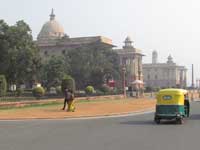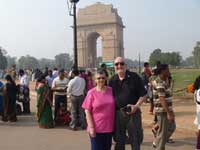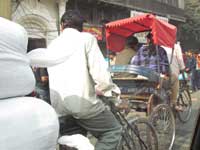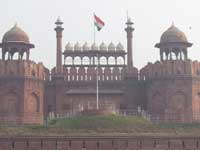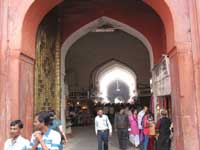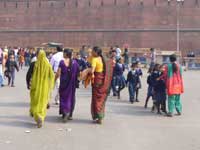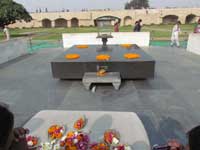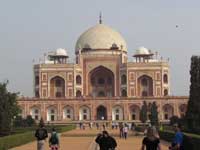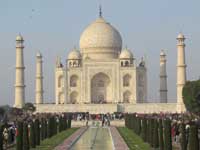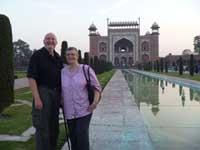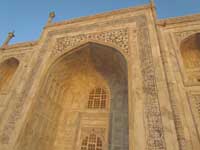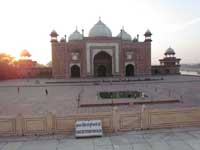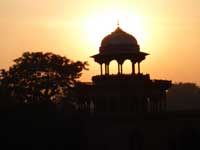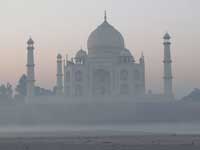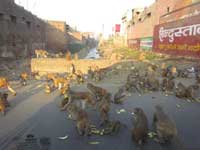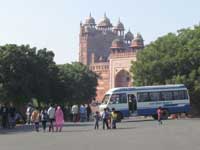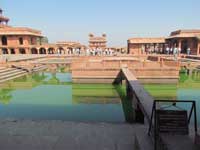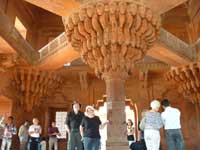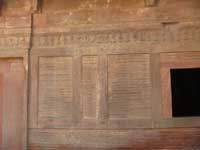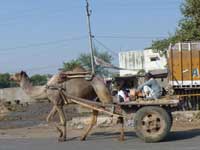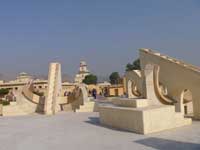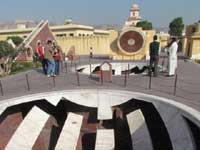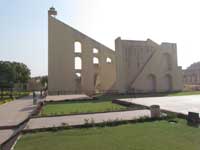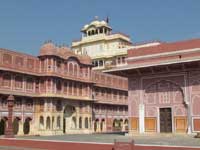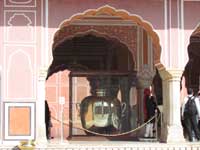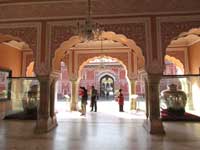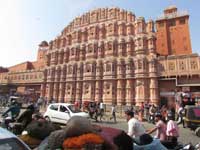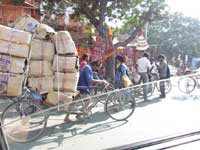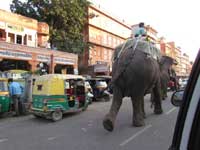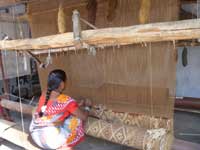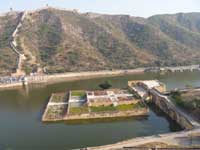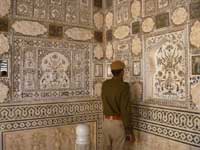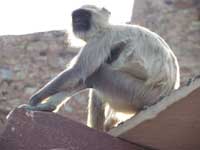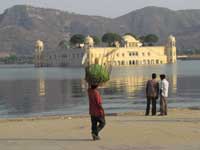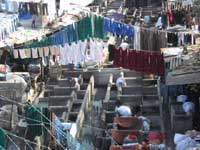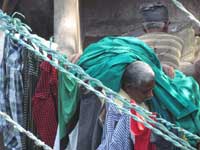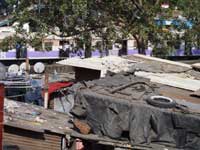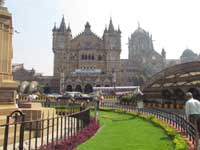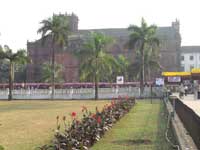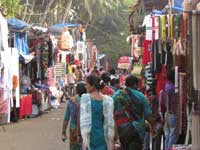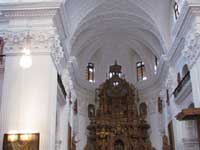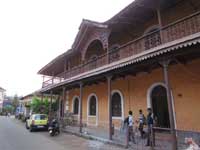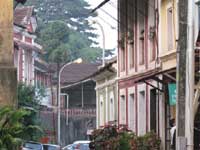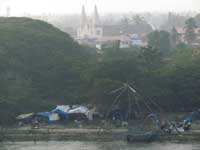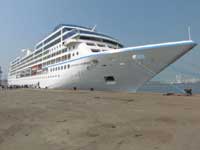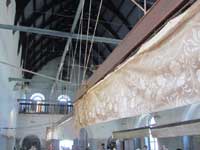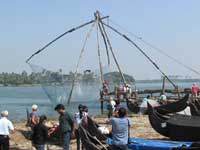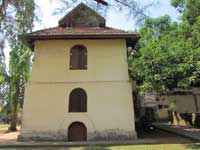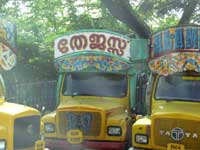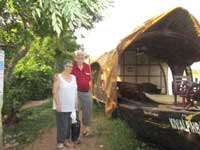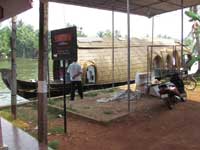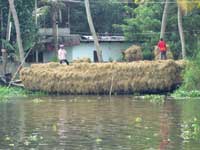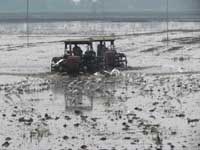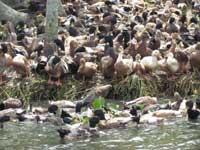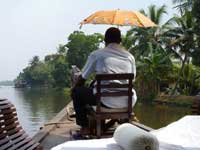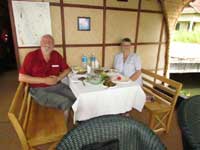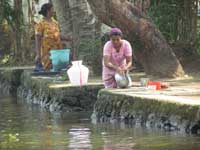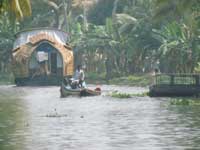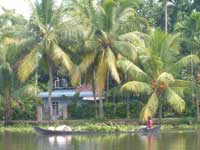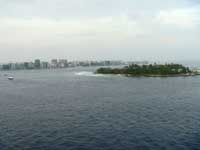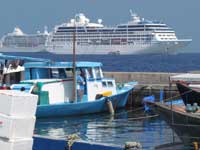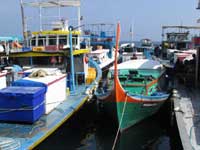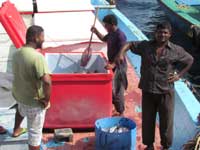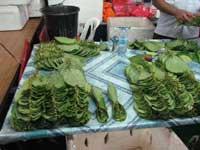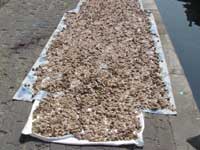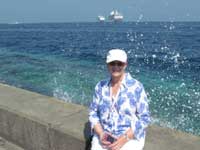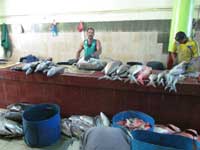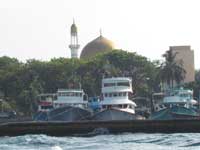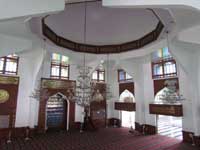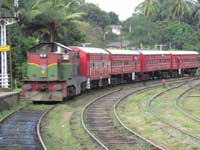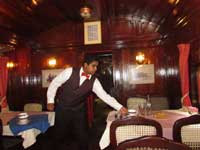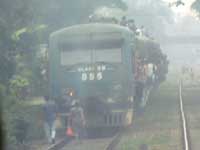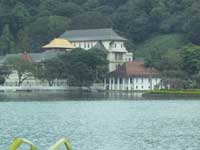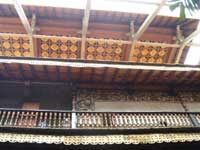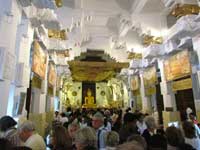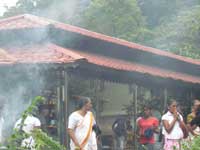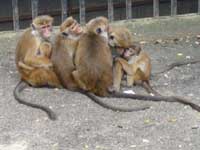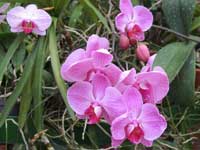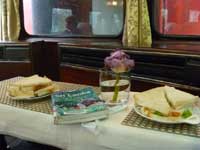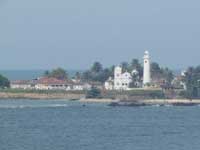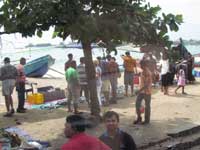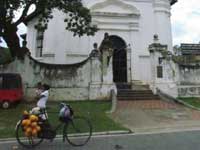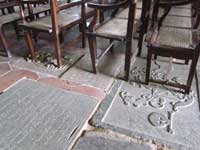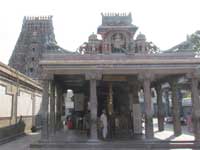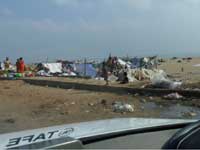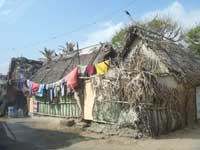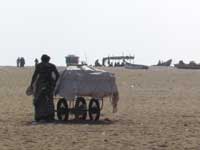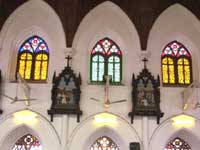India, Maldive Islands & Sri Lanka in
November and December 2012
India, Maldive Islands & Sri Lanka (download 1.5MB PDF file) | Maps
A 'Golden Triangle' land tour in Northern India (Delhi, Agra, Fathepur Sikri, Jaipur), a flight to Mumbai (aka Bombay) followed by a cruise from Mumbai round the bottom of the country to Chennai (aka Madras) via Goa, Kochi (aka Cochin), the Maldive Islands and Sri Lanka (aka Ceylon) on Azamara Journey.
For the land tour, we weighed up a number of options but decided that we definitely wanted to have a private tour with our own car, driver and guide and also wanted to stay at top-end hotels. This was not much more expensive than taking a group tour by coach and gave us complete flexibility to set off when we wanted to and add or omit visits as we wanted. We can’t stand having to hang around waiting for other members of the party.
The Golden Triangle land tour and Mumbai was booked through an excellent company called Elegant Journeys India (www.elegantjourneys.co) based in Delhi. We cannot speak highly enough of them. As regular readers will know, we don’t usually ‘advertise’ in these blogs but here we must make an exception. As you know, we are very well travelled and can honestly say that the service and, indeed, friendship and kindness, we received from the owner, Vivek Wadhawan and his agents and employees right from our very first enquiry, were without equal. Sarah has an inconvenient health issue necessitating frequent ‘pit stops’ but the sensitive manner in which everyone involved accommodated what was frequently a logistical nightmare meant that at no time was she made to feel embarrassed or a nuisance. She must have been a pain in the neck for those poor guides and drivers who were required to find conveniences at the most inconvenient moments... often when ensnared in grid-locked traffic! We not only used Elegant Journeys for the Golden Triangle and Mumbai part of our trip but also for tours in Kochi and Chennai - on every occasion the driver and guide were awaiting our arrival and the whole experience was seamlessly smooth and efficient. Vivek even called us at regular intervals, on the guides’ cell phones, usually as we were being driven from place to place, checking that all was well and that we were happy with the arrangements. He epitomises ‘Customer Service’ and this rubs off onto everyone with whom he associates; he is also a kind and friendly man with whom we will certainly book our future trip to India … Just as soon as we are able to make plans!
The cruise from Mumbai to Chennai was with Azamara Club Cruise’s Azamara Journey and we found their feature of spending two days in many ports worked very well for us - much more relaxing knowing that you don’t have to fit everything into a short visit of jut a few hours. There’s more about the ship later.
And now on to the actual trip …
Because of time differences, our 12-hour flight got us to Bangkok at 9.00pm and our connection to Delhi didn’t leave for 10 hours. We had booked one of the airport’s ‘day’ rooms, which are airside so we didn’t have to go through the tedious and time-consuming immigration and customs procedures in order to leave the airport and check in at a ‘proper’ hotel. It gave us an adequate bed, bathroom and breakfast. It all worked well and we were refreshed and ready for our flight to …
Delhi
After the four-hour flight from Bangkok we arrived at Delhi late morning. The airport is super-modern and we were amused and grateful to find that they have special immigration and customs lanes for First and Business Class passengers. Our luggage came up just as we reached the carousel so we were out within 15 -20 minutes of landing. The greeter and driver from the travel company were there to meet us and we got to the hotel about midday. A nice light lunch was followed by a long snooze and then it was dinner time and the first of many delicious curries, this one in the hotel coffee shop.
The Radisson hotel was very grand but in a newly developing area of apartment blocks in the middle of nowhere, so there was no temptation to wander off - in fact, the area reminded us a lot of Abu Dhabi and Al Ain, in the ‘80s when we were living there, especially the 'architecture' and distressing quality of the building work and finishes!
[A funny feature of all but one of the hotels we stayed at is that they have totally clear glass walls between the bedroom and the bathroom so one is on full view! They did have roller blinds (with very well-concealed switches) so that one could have privacy and the occupant of the bedroom wasn't treated to any unedifying sights!] But we digress...
The time we were in India was apparently the most auspicious time for weddings and there was a huge, 'society' wedding going on at the hotel and we had fun watching all the guests in their amazing finery - never seen so much gold outside the Dubai Souk and as for the saris and gold jewellry, WOW!!!! We were amused to see a group of western guests who had obviously been dressed for the occasion: the women loved their saris but hadn't a clue what to do with them or how to walk in them, and all the men had been given pink chiffon turbans to wear. The whole production cost a mint of money (apparently several million rupees) as there were flowers and bowers, decorations galore and liveried waiters, chefs, photographers and factotums, as well as dancing girls, all dressed almost as elaborately as the bride and guests.
Our first tour of the city was an eye-opener as we realised that fabulous jewel-coloured saris and shalwar kameez (dress and trouser combinations) worn with floaty silk scarves called dupattas, often embellished with gold embroidery, were not restricted to weddings but were worn everyday as people went about their business, adding a delightful gaiety to what is an otherwise rather dusty and monochromatic cityscape. Another welcome surprise was that the city is surprisingly clean, with not much litter. The Indian Tourist Authority would do well to highlight the way everything has been cleaned up since the reputation for dirt and smells, as well as some rather unfortunate movies and TV documentaries, put many people off visiting - not everywhere is a slum! Having said that, there were still lots of signs of dreadful poverty and beggars banging on the car window - hard to ignore but impossible to give to all.
At the centre of Delhi stands the 42 m high India Gate, designed by Lutyens. It is an archway in the middle of a crossroad. It commemorates the 70,000 Indian soldiers who lost their lives fighting for the British Army during World War 1. The memorial bears the names of more than 13,516 British and Indian soldiers killed in the North western Frontier in the Afghan war of 1919. It has been likened to the Arc de Triomphe in Paris, also a memorial to those who died in combat. The Gate and other elegant, monumental edifices built by the British are quite spectacular and would not look out of place in London, where there are so many others, all designed by the same architect.
It is the even older history which is really spectacular, though, and we spent a lot of time exploring the enormous Red Fort in particular. The red sandstone walls of this massive walled city, rather than just a fortified barracks as we might imagine it, tower above the clamour of Old Delhi as a reminder of the magnificent power and pomp of the Mogul emperors. Built in 1638, they were designed to keep out invaders but now they mainly keep out the noise and confusion of the modern city. At the entrance, the cool, vaulted arcade of a tourist bazaar originally housed the military guards and leads into the huge fort compound. Inside is a complex of magnificent buildings, each more spectacular than the last, including the Drum House, the Hall of Public Audiences, the white marble Hall of Private Audiences, the Pearl Mosque, Royal Baths and the Palace of Colour.
We had a rickshaw ride through Chandni Chowk, which is an area of narrow streets full of tiny, crammed shops and workshops. We would not have been able to do the ride that we did on any other day as it is also a bazaar, but that doesn't operate on Sundays. Other streets were lined with stalls, however, as the shops there were shut and the pavement given over to people selling second hand books - especially school books which the children buy ready for their next class at school; 'seconds' clothes from the factories which abound in Delhi; fruit, vegetables and live chickens, to mention but a few - the crowds of shoppers were overwhelming and we were glad we were not trying to negotiate the route on foot!
We visited the quiet garden and memorial to Ghandi, which was very plain, as he had wished, but all the more meaningful for that. There were people from all over the country making a pilgrimage and we saw some very colourful characters. We went barefoot, as in temples, as a sign of respect. Many westerners wore socks but we didn’t feel right with that, although we were told later that it was quite permissible.
The final place we visited in Delhi was Humayun's Tomb which is said to be the inspiration for the Taj Mahal, as it was built by a widow for her husband. This one is in (masculine) red sandstone whereas the Taj is in (feminine) white marble.
The traffic was even more terrifying than in China and we shudder to think what it must be like in the rush hour, given what we saw on a Sunday, when the roads were 'quiet'! There are lots of motor bikes with two or three, even four, people on each and we were told that the rider has to wear a crash helmet and so do male pillion passengers, but women and girl children don't - we suspect this is just a good story told to visitors by our excellent, informative and humorous guide, Harry. The general confusion is not helped by the preponderance of cattle wandering at will through the traffic, and the odd horse and cart didn’t do much to speed things up, either. As we weren’t driving, we loved every minute of the spectacle!
We were collected at 7am next morning so we could cross the city ahead of the rush hour, thus saving up to an hour on the 4+ hour drive to Agra. The route took us through areas each with their own distinct character and industry: brickworks with tall, conical chimneys; marble masons carving statues, shrines and ornamental ware and, as we neared Agra, huge cement works. There were also high, flat sided buildings with no windows which turned out to be family compounds, with the windows facing inwards for privacy and protection from the hot sun. Farming was evident all along the route, with adjacent farms using either shiny new tractors or bullocks pulling ploughs and carts and human labour using wooden picks to work the earth. The labourers were mainly female (of all ages), as far as we could see, though perhaps they were more visible due to their brightly coloured clothes, eclipsing the men in their more sombre shades of brown and beige. There were lots of round huts with conical, woven-leaf roofs but we were unable to find our exactly what they were - labourers’ homes, storage ‘sheds’ or animal shelters?
Agra
We arrived in Agra at around mid-day and absolute chaos reigned on the roads, with, tuk tuks, tongas and trishaws, bullock carts, laden donkeys, overloaded bicycles and motorbikes, trucks, buses, cars and cattle forming four or five lanes across a one lane road - interesting when it narrowed to a one lane bridge! As it always seems to, it all sorted itself out eventually and we were soon on our way to the Radisson hotel for a late lunch before our first visit to the Taj Mahal. We got our first glimpse of this most breathtaking of sights as we drove along the river when it quite unexpectedly appeared in the distance through the haze. We had wondered why the driver had slowed down at that particular spot but when he pointed and just said “Look!” we could see why. Our first impressions were of size (we really hadn’t expected it to be so big) and the graceful elegance of its unmistakeable silhouette.
After a quick wash and brush up and delicious lunch our charming guide, Divya and driver Rajesh, picked us up and we headed off. Our guide was excellent and got us to the front of every queue and also, having seized one of our cameras, somewhat embarrassingly bullied all the other visitors, mainly Indian, out of the way so she could take our photos. Divya was such a sweetie that even Martin agreed to far more than he really had patience for! Sarah was determined not to have her photo taken on the “Princess Diana bench” but Divya was so disappointed that she relented, so can now boast that her sit-upon has sat-upon the same spot as the royal sit-upon! Enough silliness, let’s visit the most romantic and beautiful monument in the world.
The building is pure white marble and looks very plain from a distance. As you get close to it, however, you see fabulously delicate inlay work, all in semi-precious stones like turquoise, lapis lazuli, malachite, cornelian, mother-of-pearl and even abalone/paua (to us Kiwis), so it is actually very ornate. There are also a lot of bas-relief carved wall panels and some fantastically intricate lattice-work screens, all marble and each made out of a solid piece - the slightest mistake in the tracery meant the whole thing had to be abandoned and started afresh; no wonder it took 20,000 artisans 22 years to build it. We stayed until after sunset and watched the colours change from white, to cream, to pale yellow to a lovely mellow buttery hue, then back to an almost pearly white as the sun light gradually disappeared.
The crowds were phenomenal and they 'restrict' the number of visitors to a ‘mere’ 10,000 a day, with only so many allowed in the main mausoleum at a time - a guard blows a deafening whistle when time's up and you have to move on. An advantage to being just two of us was that Divya, who of course knew all the staff, was able to negotiate extra time for us, so we got a comparatively quiet few minutes between one group leaving and another arriving, which we greatly appreciated as we were able to soak up the atmosphere of this magical place. We spent over three hours at the Taj Mahal but would happily have stayed even longer.
We spent some time on the way back to the hotel at a marble inlay factory where the artisans are direct descendents of those who built the Taj Mahal. It was very interesting and we saw some exquisite work but everything was far too expensive to even be tempting, so our airline luggage allowances were not in jeopardy.
The following morning we went just before dawn to a spot on the other side of the river, to watch the sunrise and see the changing colours again. When we arrived the dew was still on the grass and mist was rising from the river, making the pearly Taj look quite ethereal. As the sun rose and the sky turned from light grey to rosy pink, so did the marble and it suddenly seemed to come to life. We expected that there would be crowds there to view the dawn spectacle as it is definitely a 'must do' but we were so lucky and were the only people there, so were able to enjoy the mystical tranquillity in peace. It was also nice to see it without thousands of people crawling all around, as we had the day before. Once the sun had risen and the sky turned blue it was 7.30 and the first visitors of the day came into view on the terraces, so we had timed it perfectly as we were then due to leave and head back to the hotel for breakfast and check out.
We left Agra on our journey to Fathepur Sikri and onward to Jaipur. Our guide Divya was to accompany us as far as Fathepur Sikri and the same driver would then take us all the way to Jaipur, so we were in good company. On the way out of town we saw hundreds of monkeys, all over the town as they are allowed to run wild. They represent the Hindu God, Hanuman. and as it's his day of worship on a Tuesday, all the Hindus who follow Hanuman feed them bananas; we don't know who cleans up all the peel when they've finished them but we certainly wouldn’t want the job! Actually, we were surprised as we had thought they would scoff the bananas whole but they peel and eat them exactly the same way we do - another useless snippet to add to our store of Quite Interesting facts (with apologies to Stephen Fry) picked up during our years of travel. Some people we met later made the same observation, so it’s not just us!
Fathepur Sikri
Fathepur Sikri is the magnificent, deserted Mogul city, made of red sandstone with all the buildings beautifully carved with animals, birds, arabesque patterns and calligraphy; all looking as fresh today as the day it was made in the 1570s. It would take all day and more to explore it all, and we didn’t have time to spare, so we chose to visit the main living quarters (a town within a town, almost), where the carvings are the most elaborate. We were amused by a relief round the wall of the queen's rooms as it depicted hundreds of pretty little designs, which the guide told us were actually pictures of the queen's favourite earrings, of which she was an avid collector; a nice domestic touch. The most extraordinary room, though, was where the king sat to receive his nobles. It has a central pillar with a platform on top (about 3 metres above the floor) and radiating from the platform are four walkways leading to some benches where the nobles sat until it was their turn to join the king on the platform; only the king and these confidantes were allowed to use the staircase up to the gallery. Apparently it was built like this so that the common folk and even nobles not in the 'inner circle' could not over-hear what was discussed - it all looked very precarious, but beautifully made.
As so often happens, we encountered some rude foreigners, this time Brits on a package tour, we’re sorry to say. They were loud-mouthing off about a small extra charge (less than 2 dollars) for a 1km electric bus ride to the entrance to the Taj Mahal being a rip-off, as motor vehicles are not allowed nearer. One said she refused to pay and another said she paid but under protest and told the guide she would be reporting it to head office and would expect a refund as the holiday was supposed to be fully inclusive. They still rode on the electric bus, however, and the poor guide had to pay out of his own pocket for the woman who wouldn't. Pity he didn't just tell her to walk, as anyone else who couldn't or wouldn’t pay was doing. The women then started talking about 'they' being only interested in what they could con out of you blah, blah, blah - all in front of Divya, who had shown us where the loo was, and looked after them, too, when they tagged along with us. Sarah was so embarrassed that she felt she had to apologise to Divya (loudly enough for them to hear) but she said she was used to it and knew that not all westerners were like that.
We left Fathepur Sikri around mid-day and started the long drive to Jaipur but before we could leave there was a message from Vivek telling us to wait as another driver had been dispatched to bring us a gift. This was a model of the Taj Mahal encased in a pen holder ‘snow’ globe; such a very kind thought and one we very much appreciated. We also had to bid farewell to our delightful Divya, which was sad for us, though we knew her four year-old daughter would be pleased to have her back.
The drive took us from Uttar Pradesh to Rajasthan and we found the journey most interesting. We saw many ‘factories’ making dung discs for fuelling cooking fires. These were made by excavating thick mud and mixing it with a little straw and a lot of animal (mainly buffalo) dung until the consistency was right to be shaped into discs the size of Frisbees, which were then baked in the sun and, when dry, piled up in conical mounds to be sold. We had wondered at the particular pungency of the early-morning smoke from the cooking fires but now understood. We were glad of the air-conditioning and closed windows of the car as we drove past these enterprises, as we imagine that they must have been quite whiffy in the hot sun. We saw girls with water pots on their heads going to the well, their deportment was grace personified and Sarah caught herself thinking that some of our unattractively slouching western girls could learn a thing or two from them. In fact, during the whole time we were in India, we didn’t see a single female, of any age, who failed to carry herself in such a graceful manner, not even the modern types in the big cities, in their jeans and t-shirts and stiletto heels.
We encountered lots of camels, some pulling carts, and even a camel caravan of some dozen or more of the beasts, with some baby ones bringing up the rear; buffalo and even an elephant moving huge logs were also to be seen. There were also brightly coloured parrots flitting around at low level, but they couldn’t compete with the brightly coloured clothes of the women - even more riotous than those we had seen in Delhi and Agra. Rajasthani women are renowned for their love of colourful, sparkly clothes and in addition to gold and silver thread; they also sew little mirrors onto their fabrics. Rather than saris, many wear very full, heavily embroidered silk skirts with loose, matching or toning embroidered blouses. They make for a breathtaking spectacle, especially when gathered in a crowd, as at a wedding - of which we saw several. As before, there were many vegetable farms along the way and these jewel-bright fabrics made the women toiling in the fields stand out against the rich, dark soil.
Jaipur
We arrived safely in Jaipur, thanks to our excellent driver, who had managed to avoid the terrifying trucks and motorbikes which periodically hurled themselves towards us, travelling at speed the wrong way along the dual carriageway! We had a lazy evening and early night at the Sheraton hotel before another long and busy day, starting at 9.00am for sightseeing and ending, we hoped, in Mumbai at around 11.30pm after our late-evening flight.
As elsewhere, vastly overloaded vans, trucks and buses filled the streets, together with camels, elephants and horses adding to the gridlock in the city. Everything was so chaotic that it was hard to get pictures - but if you remember what you've seen on films, TV documentaries and even some of those emails which do the rounds, you will get the picture as they certainly do not exaggerate.
Many of the elephants were painted with bright coloured designs and hung about with golden tassels and red velvet cloths and these were being used in wedding celebrations (did we mention we saw a lot of weddings?). On several occasions we saw young men, dressed in sparkling and sparkly white outfits, with coloured silk turbans or head-dresses, riding through the city on similarly decorated white horses and we were told by our friendly local guide, Ashok, that they were bridegrooms on their way to their weddings.
Jaipur is known as The Pink City because all the buildings in the old, walled, part were painted pink when Prince Albert (Queen Victoria's husband) visited, because the Maharajah thought it was a nice, welcoming colour and anyway, made the place look tidier! All the shop signs are plain black on white but it is saved from being dull by all the incredibly ornate carving and decoration on the floors above street level.
The first place we visited was, deservedly, a World Heritage site: the Jantar Mantar observatory was built in the early 1700s, before there was a distinction between astrology and astronomy. The huge instruments were sundials, astrological 'charts', others to identify where the sun is in the northern and southern hemisphere and lots more; they are still remarkably accurate, allowing for time differences throughout the world and across the Indian sub-continent. If you would like to know more about this unique site, do look at the UNESCO website. We quote their introduction here: “The Jantar Mantar, in Jaipur, is an astronomical observation site built in the early 18th century. It includes a set of some 20 main fixed instruments. They are monumental examples in masonry of known instruments but which in many cases have specific characteristics of their own. Designed for the observation of astronomical positions with the naked eye, they embody several architectural and instrumental innovations. This is the most significant, most comprehensive, and the best preserved of India's historic observatories. It is an expression of the astronomical skills and cosmological concepts of the court of a scholarly prince at the end of the Mughal period.” We had no great expectations of the observatory and really only went because it was a ‘must see’ in Jaipur. In the event, we would have liked to spend twice as long there and it certainly ranks as one of the most interesting surprises we have encountered in all our travels.
Next was the Royal or City Palace with its courtyard of beautifully tiled balconies forming peacocks and other fabulous creatures, where the ladies used to sit and watch the processions and ceremonies. There is also a magnificent meeting hall with the largest carpet in the world. There are numerous chambers, each with myriad precious artefacts on display, far too many to describe here but easily found on the internet if you are interested in seeing more. Of particular interest are the two Silver Pots at the entrance. Standing 1.6 metres tall and weighing 340kg, these grand vessels can each hold 4000 litres. They were made for Maharajah Man Singh II in 1901, before he went to England for the coronation of King Edward VII. As a devout Hindu he did not want to drink the “English Water” as this would be a sin against his religion, hence he ordered these two huge urns to carry Ganges water with him. These Silver Urns have found a place in the Guinness Book of World Records as the largest silver pots in the World. A museum of textiles was another highlight and Sarah marvelled at the opulence of the robes worn by the Maharajahs and Maharanis - the embroidery and fine needlework were quite exquisite.
One of the things we remember most about visiting this Palace, however, is that it was the first time we walked anywhere which necessitated crossing the road - took years off us and turned our hair white. Fortunately we didn't have to cross back as our car was brought round to pick us up on the right side of the road!
We also went to a demonstration of block printing on fabric (Rajasthan is famous for this) and carpet weaving. At the carpet-making centre we saw camel hair being spun into yarn then dyed using natural dyes. Then we were shown how the beautifully patterned and coloured carpets are woven and finished - a process which involves setting fire to the backs with a flame-thrower type implement to burn off excess fluff, an alarming experience, given the confined area where the demonstration took place!
We asked the guide if we could visit what is one of the most famous of Jaipur’s tourist attractions, the beautiful Palace of the Winds. We were astonished to find that this magnificent edifice is, in fact, little more than a façade, with a very utilitarian, far from palatial rear. It supports a maze of staircases leading to layers of niches and undecorated, ornamented hanging boxes, with lattice-work screens looking towards the street and the city. Built at a time when royal ladies observed very strict purdah, these 900 screened boxes and niches, enabled the ladies of the royal household to watch processions and activity on the streets below without being seen themselves. The apparently fragile palace, to which those delicate women were brought on palanquins carried by servants, belies its appearance as it has now stood since 1799 without any obvious deterioration.
After a delicious lunch back at our hotel (sadly, we didn’t eat ‘local’ as we just didn’t want to risk getting ‘funny tummies’) we had a visit to the Amber Fort. You could opt to ride up to the fort on elephant back but, having done that a few times before, we opted to drive up in our car. Incidentally, we were encouraged to hear that the welfare of the elephants is an important consideration and they are only allowed to do five trips a day, in the cool of the morning, to avoid overworking them.
More fabulous rooms lined with tiles and artefacts - most spectacular was a hall lined with tens of thousands of small mirrors and mirror tiles, where it is said, a single candle could light up the room. Sarah was amused by one of the soldiers guarding the place, who stepped over the rope keeping people from getting too close, and proceeded to use one of the mirrors in which to preen. This fort had the most spectacular gardens and lake views as well as views of surrounding forts and connecting walls, which look exactly like The Great Wall of China (though red sandstone, not grey granite). We were surprised that the Indian tourist authorities don't make more of a feature of them as they certainly impressed us and everyone else around us, as far as we could tell.
[Most of the visitors everywhere we went were Indian, many from outlying areas and, as in China, we were much stared at and photographed. Sarah met a nice German girl and got chatting - she is travelling the world and two months ago was in a small town called Mangonui, where she had fish and chips after a great bus trip on the beach and to a lighthouse called Cape Reinga at the northern tip of New Zealand - you couldn't make it up!]
On the way back from the Amber Fort, we passed a beautiful lake palace, attainable only by boat. We though that it had sunk as the ground floor doors and windows were semi-submerged but were told that the Maharajah who built it liked to take his boat right inside, presumably to avoid spoiling the symmetry of the building with docks and jetties tacked on to it. Along the esplanade in front of the palace there were fruit vendors who seemed to compete to carve and arrange their fruit to look the most appetising - and it did! There was also a chap carrying a sort of unfinished basketry arrangement on his head but we couldn’t make out what it, or its contents were.
[All the ancient sites are heavily guarded and security is tight everywhere in India, especially at the hotels and whenever we drove in they inspected underneath with a mirror and also looked in the boot and under the bonnet. We had to go through airport-type security and have our luggage scanned, though regardless of how many bells and whistles went off, the guards ignored them and just wished us "Welcome Sir, welcome Madam", so we couldn't help feeling that it was all a bit pointless. It's all since the big terrorist attack on the Taj Palace Hotel in Mumbai a few years ago, so one can understand the jitters.]
At the airport our luggage was found to have put on 3kgs of weight – intriguing, since we hadn’t bought anything! However, we coughed up the modest excess baggage fee and went on our way. The 1hr 45min flight got us to Mumbai at 12.15am (nearly an hour late) but we were met by another of Vivek’s efficient representatives and drivers. We were in the Holiday Inn hotel by 1am and fast asleep just minutes later, after a long, tiring but memorable day’s sightseeing.
Mumbai
After the dazzling colours and sparkly clothes of the people in Agra and especially Rajasthan (Jaipur), the crowds in Mumbai seemed quite drably dressed - it is definitely a more cosmopolitan, business-oriented city and, on the face of it, less exotic. For example, the spoil-sports have banned tuk tuks, horse and camel carts from the city and elephants, too, as they cause too much traffic chaos. Actually, we don't see how they could make it any more chaotic, but there you are!
The first attraction we visited in Mumbai was the one we were most interested to see, Dhobi Ghat. This is a vast (and apparently filthy) laundry, seemingly used by the whole population of the city as it only costs about 1 rupee (there are 42 rupees to the NZ dollar) per item, collected, washed, ironed and delivered. We were amazed at how white and clean they got everything and, as you can see from the photos, how astonishing it was that they could manage all that fetching and carrying without anything getting lost or mixed up. Many of the launderers live there in the make-shift shanties between the laundry and the railway, which you can see in the photos. If we had to sum up India in two words, they would be 'Organised Chaos' and Dhobi Ghat illustrates this as nowhere else.
Dhobi Ghat is right by the railway line and if you look closely at the photos you can see people hanging out of the train doors - they are not about to jump off but the trains are just so crowded and they were the last ones on - at the next station, presumably, the new arrivals will take to the roof. We saw this again and again throughout our travels in India and Sri Lanka, and it was then that we understood why the tour companies don’t even try to transport tourists by train.
[The same situation applies on the Sri Lanka railways and when we were there, some Australians whom we met on the cruise, told us that they had decided to take a train a few stops, just for the experience and to get a different view of Colombo. Having paid their 60 cent fare they boarded to find standing room only but assumed the majority of the passengers would be commuters who would leave the train at the next station. They asked a seated gentleman if this was the case but were told that they would almost certainly be going all the way to Galle. By this time the train was still more crowded and our friends decided that, since it was now too hot, smelly and uncomfortable and besides, they could no longer see out, they would alight and forgo the ride. Working their way to the door through the press of bodies was an experience in itself and one they didn’t care to repeat: “60 cents wasted but sanity restored” was how they put it.] There will be more about Sri Lanka later. Meanwhile, back to Mumbai...
The next stop was to the house of Ghandi’s friend, where the great man stayed whenever he was in Mumbai. We saw his humble room, kept as it was when he used it, and hundreds of photos and letters, etc. It was a small house and short visit but one we are glad we made as we learned a lot about his early life and gleaned a greater understanding of the man and his accomplishments as a result.
The phantasmagorical Victoria Terminus railway station was next but it was so O.T.T. it is almost impossible to describe - suffice it to say it makes the old St Pancras Station in London look positively Spartan! There were lots of other colonial era buildings, statues and fountains so it was easy to imagine what it must have been like in those days. We went to the Gateway to India arch, which was hugely impressive, set on a busy harbour front with hundreds of boats and ferries adding colour and bustle. The usual food vendors, trinket, postcard and souvenir sellers, shoe polishers and sundry other hawkers, peddlers and tricksters wove in and out of the crowds and although one was constantly accosted, they were seldom insistent and it really all just added to the colour and atmosphere.
Opposite the Gateway is the Taj Palace Hotel, one of the most famous in India. We were ready for a 'pit stop' and coffee but although we managed the former, we were thwarted by the latter as we were not resident, nor members of a tour group - not very friendly.
As it was now time to head for the ship, we didn’t get to see another famous feature of Mumbai life: tens of thousands of lunches prepared and stored in multi-layered 'tiffin cans' for delivery by bike or on foot to offices, shops, etc, for the workers who had ordered them, for just a few rupees... another example of the organised chaos which always seems to work so well - though it is a wonder everyone gets the right food. Never mind, we can save that for the next time we visit India, which we definitely intend to do before we are too much older.
The good ship 'Azamara Journey'
More organised chaos met us at the port, where dozens of smiling, willing hands were there to assist, but were unable to tell us what we had to do! Luckily our tour guide and driver had been there before and knew we needed special passes, where to deposit the suitcases, etc. etc... by no means obvious. Having negotiated our way through that, we arrived at the check-in counter and were processed immediately - no queues at all. Within 15 minutes of arriving at the port, we were on board and would have been in our cabins had we not been way-laid by jolly waiters bearing glasses of pink champagne to welcome us aboard... it would have been rude not to! We had not sailed with Azamara Club Cruises before and were not sure if they would be worth the rather higher rates than we normally pay, but so far everything was looking very good indeed!
Our cabins were ready even though we were earlier than scheduled and our suitcases had arrived too - unheard of! We decided to go for lunch before unpacking and had a nice surprise at the buffet restaurant as the food was excellent; fresh, hot when it should be and cold when it shouldn't, and an excellent selection. We normally avoid the buffets, or ‘The trough’ as we generally dub them, but this was remarkably civilised and we became regulars for breakfast and lunch, only using the main dining room for dinner.
Wine and soft drinks are free at meals and ‘proper’ coffee was freely available at all times; the barista learnt the first night that Sarah’s quarter-shot skinny lattes are really just pale beige milk and that Martin’s double espresso meant just that and they never failed to get it right during the length of the cruise. At meals, we found we had a job to stop the waiters constantly refilling our glasses - we only expected one glass each so got caught out a couple of times before we realised the level didn't seem to be going down...hic! There were regular cocktail parties, when more champagne was served, with delicious canapés. As we had paid for some excursions before embarkation (Goa, Kochi and Colombo), for most of the cruise our account actually stood at a minus sum, as Azamara refunded a tax which was presumably not levied after all (we never did find out what this was).
We could even have had afternoon tea and cocktail snacks and canapés served to us in our cabin if we wanted... but they were available in all the bars and the proper coffee cafe area all day too, not that we ever had the appetite to indulge; three large meals a day being quite enough and more than we are used to.
There were fresh flowers and fruit in our cabin as well as complimentary mineral water and soft drinks in the mini-bar and lovely toiletries, too. We found the bed very hard the first night and mentioned it when the cabin boy asked if we had slept well. He promptly got us a 'pillow-top' mattress pad and it was just fine. The launderette was free and there was no extra tipping, so all-in-all, we were very happy matelots.
[We made friends with a number of people straight away and there was always someone to chat to or go in to dinner with. There was an interesting post script to the ‘excess baggage’ incident at Jaipur: we spoke to a number of people who had done very much as we had before joining the cruise and all those who flew from Jaipur had exactly the same experience … all 3kgs over! The charitable explanation is that their scales were not properly calibrated but on the other hand, all those modest fees would have added up to a tidy sum over the course of time...]
Goa
Goa was the first port-of-call and we were greeted by traditional dancers and "Goa's world famous top beat singer" - well, the dancers were nice! Girls in lovely national dress welcomed us to Goa as we stepped off the gangway, strewing us with jasmine and handing a red rose to all the women - such a lovely gesture. We took a ship’s tour as they were exceptionally good value when booked in advance and at that time we were unsure about the availability of do-it-yourself options. The tour was to Old Goa and three of the oldest churches. The drive was very interesting with lots to see of the way the people lived, and that was what we really went for, as the port was 40km from the town so wandering around locally wasn't an option. We were intrigued to see literally hundreds of barges lying idle and ‘mothballed’, with the consequent loss of income for the owners, captains and crew.
[Apparently, the barges were used primarily to move the products of the mining industry but the Goa local government had summarily closed down all mining in the province while the rampant corruption was dealt with. A somewhat drastic step, we thought, until it was pointed out that the depth and widespread nature of the corruption was such that it would have been impossible to ever discover its true extent and who the main culprits are as long as the industry was allowed to function. It is a laudable aim as there is no doubt that corruption is sadly endemic in India, and it is therefore encouraging for all the many principled people that something is being done to stamp it out. Though at what a cost to the workers whose jobs are effectively gone, since it is thought that the investigation will take years.]
The churches we visited were built by the Portuguese 400 years ago and one of them contains the remains of St Francis Xavier. Another was built as a half-sized replica of the church of St Peter’s Basilica in the Vatican and you can see that might be the case, but it was totally undecorated (except for the altar screen of course) and we actually liked it better for that! The most interesting one was nominally a cathedral, though the same size as the others. It was a little more ornately decorated though still not with the flamboyant opulence of Catholic churches in Europe. What we found most interesting was there were several women, obviously in their best saris and jewellery, doing some very devout praying, singing hymns and prostrating themselves at the altar steps. It was quite humbling to witness such piety and lack of self-consciousness when surrounded by tourists; we do hope their prayers were answered.
[Several times during our travels in southern India we found ourselves in churches while services were being conducted, on one occasion a funeral, or as here, people were praying but it was considered perfectly acceptable and no-one batted an eyelid at the incursion of foreign tourists. Of course one was quiet and behaved with decorum, explanations by the guides being saved for outside, but we still felt somewhat uncomfortable and wondered how we would view strangers walking in on the funeral of a loved one, for example.]
On the way back to the ship we stopped in the town where there are still a lot of the old, Portuguese houses and Martin went for a guided walk round the streets to see them. Sarah’s knees and back had given out by then, so she stayed on the bus with a few other crocks. The guide said it would be a 15 minute walk but we've learnt that India works on 'rubber' time and in the event they were actually a good half an hour, though Martin did enjoy it and found it was well worthwhile. The drive back was interesting again, as darkness had fallen and everything looks quite different by firelight, 20 watt electric light or naphtha flares. All the shops and businesses open at night (they were closed during the heat of the afternoon) and there were lots of shops, many of them just selling alcohol, and bustling, colourful markets which we would have liked to wander through, had time and proximity to the ship permitted.
As we sailed away the next evening, we saw fireworks but don’t know whether they were for our benefit or a wedding ashore - probably the latter as it was the wedding season… oh, we may have already mentioned that!
Kochi (aka Cochin)
Kochi, in Kerala, was the next port-of-call and as we sailed in to the port, we passed the fishing village which is renowned for the Chinese fishing nets. These graceful constructions were originally thought to have been brought to India from China by Zheng He but this was never verified and it is now thought more likely that they came with the Portuguese who travelled to India from Macau. Whoever introduced them; they are a magnificent sight and rank as one of Kochi’s most popular attractions. They are big, wooden mechanical structures which look similar to a catapult at first sight. The nets are permanent structures situated on the shoreline and each village will have several of these clever contraptions. This is because each installation has a limited operating depth therefore individual nets cannot be continually operated in tidal waters. Different installations will be operated depending on the state of the tide. Each structure is at least 10m high and up to 20m across. The structure comprises a cantilever with an outstretched net suspended over the sea and large stones suspended from ropes as counterweights at the other end. The system is so finely balanced that the weight of a man walking along the main beam is sufficient to cause the net to descend into the sea. Each installation is operated by a team of up to six fishermen, who sell their catch to passers by within minutes of the fish leaving the water - it doesn’t get any fresher than that! There is a good clip on YouTube showing how the nets are operated.
The previous day (fortunately spent at sea) a number of passengers went down with ‘funny tummies’ and Sarah had the bad luck to be among them - somewhat frustrating as we had managed to avoid any such unpleasantness all the while we were touring. We were booked on a three-hour morning tour and although feeling much better, as there was no certainty of available ‘comfort breaks’, she decided to skip the tour and Martin went on his own. Here we should note that Azamara refunded the unused excursion ticket without being asked, even though we hadn’t given the requisite notice of cancellation nor a doctor’s certificate - top marks to them!
Martin found the excursion interesting, with visits to a church where the remains, or at least a relic, of the great navigator, Vasco da Gama, is interred. This was followed by a Dutch palace which housed a museum which gave a fair indication of the history of the area and, finally, a synagogue. Martin didn’t actually go into the synagogue as by then he was feeling somewhat enervated by the heat, which, due to the press of people, was even more oppressive inside, in spite of the shade. He decided that a cool café and a long drink of fresh lime soda were more attractive at that moment. There was one ‘craft’ shop on the itinerary but one sniff of the overpowering smell of sandalwood made him feel quite nauseous so he had a wander round the neighbourhood and soaked up the local atmosphere, which was much more our sort of thing than souvenir or craft shops, anyway. The three-hour tour ended up taking four and a half because some people cannot tell the time, especially when shopping (apart from the one craft shop, it was not a shopping trip), which did nothing to improve the humour of the other 40-odd hot and sticky tourists, Martin in particular! He remembered then why we had booked most of the rest of the excursions privately with our own driver and guide.
It is unusual for Martin to be so sensitive to heat and smells and we were worried he might have picked up ‘The bug’ but later on in our travels we went into another shop selling sandalwood and he had to leave that one, too - he obviously just has an intolerance of the stuff, so no more worries about impending illness. By the afternoon, however, he was fine and so was Sarah. This was just as well since the next day brought a much-anticipated day exploring the backwaters of Kerala by houseboat.
The Backwaters of Kerala
Our driver was waiting for us on the quayside and the drive from Cochin to the boat was about an hour and a half through countryside and many small, bustling towns, all with chaotic traffic and colourful markets. People were everywhere going busily about their daily lives (women) or sitting and standing around gossiping (men), children going to and from school in their immaculate uniforms (pristine even on the way home after a day at school - I wonder what their trick is?). We arrived at the houseboat 'dock', really just rickety planks along the river bank, and were astonished by the number and variety of the boats; we immediately fell in love with ours.
Our friendly driver delivered us into the hands of our trusty captain, cook and general assistant and assured us he would be back on the river bank when we returned about 5 hours later. We were welcomed aboard with fresh lime juice and bottles of mineral water, and shown the facilities including a nice clean bathroom and even a bedroom should we want a nap! And miss all that wonderful local life and colour along the banks? Not likely! We were very excited to see women scrubbing cooking pots and doing the laundry in the murky water. Lots of men and women were bathing and washing their hair in the river, too. After the first fifty or so such scenes, we realised that this was commonplace activity and stopped taking photos (thank goodness for digital cameras). It soon became apparent that these waterside activities were not restricted to the poorest people who used the river as their pot-room, laundry and bathroom, but even the more affluent of the households did, too
We saw lots of huge gatherings of ducks (literally thousands of them) and were told that they are used to fertilise the paddy fields, and then are eaten (perhaps with rice?). There were paddy fields behind the raised causeways all along, some being ploughed, using extraordinary tractors, and replanted, with the ducks all being herded to these fields. Meanwhile on the other banks, the paddies were brilliant green, with the rice ready to harvest. As this is done by hand, we could see people in bright clothes doing this back-breaking work; we almost felt guilty reclining in our comfortable chairs taking photos of them. We also saw overloaded barges, trucks and trailers as well as stacks of the rice straw, which is used as animal fodder - nothing is wasted. Interestingly, the rice is a variety called red rice and we had some for our lunch; it is white but with red 'veins' and tasted more like Arborio than our usual favourite, basmati, but was very good and filling. Apparently some is exported but we've never seen it in the shops - must look out for it.
There isn't a lot more to say about it really as it was just a lovely day mooching on the water watching the daily lives of the local people, who seemed to be living exactly the same way as their ancestors hundreds of years ago.
When we heard what a rushed experience those on group tours had experienced, and seen the large, crowded day boats that some had been taken on for just an hour, we were so glad we’d had our smaller vessel to ourselves. It was so quiet and peaceful and we even had our own chef on board who prepared us the most delicious curry lunch - then in the afternoon the cook brought us banana fritters for tea - delicious! Even though we were out for over 8 hours, we felt relaxed and refreshed when we returned to the ship having enjoyed an absolutely perfect day, one we shall never forget.
After another relaxing day at sea we arrived at Malé, capital of the Maldive Islands. Isn't it funny how the things one expects least of so often turn out to be surprisingly interesting and enjoyable? Malé was a case in point.
Malé, Maldive Islands
Martin had been hoping to get a round trip on a seaplane taxi which calls at the various atolls if it wasn’t fully booked on the day, which he had provisionally arranged before we left home. Unfortunately he received an email saying the seaplane taxi was fully booked with 'proper' passengers and they therefore couldn’t accommodate him. It was the first and only thing that hadn't worked out perfectly on this whole wonderful trip so he soon got over it and we set off to explore. We did enquire about a seaplane fight-seeing trip but were told it would be US$1000 so kicked that into touch fairly rapidly! It was a shame we wouldn't see the atolls from the air but we were still able to experience the fabulous turquoise water from sea level and there was a perfectly circular atoll right near where we were moored.
We went ashore in Malé via tender as the ship had to anchor off due to inadequate moorings and shallow water in the harbour. We were not expecting much of the town as from a distance it just looks like any high-rise city, how wrong can one be?
The harbour was crammed with fantastically colourful fishing boats, many with high, arching prows, and they looked very exotic, especially with the huge golden dome of the mosque as a backdrop. Our timing was good and as we walked along the quayside, we watched the fishermen unloading their catch - all by hand, and as the fish were huge yellow fin tuna, barracuda and kingfish among other, smaller varieties, it was very heavy work. One fisherman saw us taking photos and immediately posed with two of his (decidedly more modest and lighter-weight) catch and there was much jollity while the others ribbed him about it. Everyone was very friendly and no-one had their hands out for tips.
We arrived at the market sheds, where thousands of bunches of plantains and bananas, both green and yellow, coconuts, papaya, betel nuts and leaves as well as many types of unrecognisable vegetable produce was on sale. There were also rows of smoked and salted, dried fish adding to the oddly appetising aromas. We carried on walking along the breakwater behind the market and came across some sheets on the ground upon which men were spreading what looked like large, sliced nutmegs to dry. As we continued our walk along the breakwater, we saw hundreds of beautiful, colourful fish in the crystal-clear water, which we tried to capture with our cameras - and now we have some lovely photos of the colours in the sea, but only we know what's swimming in it! Everywhere we went, there were people fishing or going about their daily business - one chap at the end of the breakwater had just finished gorily gutting his catch - tipping the resulting litres of dark blood back into the sea. We wondered if there had been sharks around they might have been attracted to it, but there were none so we were saved that 'thrill'.
After that, we crossed the road (taking our lives in our hands - so many kamikaze motor scooters!) and went to the fish market where we saw some of the catch we had watched being landed go on sale. It was a fascinating, busy, noisy place and we were especially interested to see the area where people took their purchases to be scaled and filleted - the workers' hands moving so fast they were a blur. All the fish was laid out in tidy rows in size order, or else artistic patterns in he case of the smaller, more colourful ones but there was no fishy smell, which just proves how fresh the fish was, and how meticulous the clean-up must have been after each session.
As well as the fishing boats, the harbour was bustling with water taxis, plodding ferries and show-off speedboats and it was these latter which caused the splashes which Martin cleverly caught on camera; the sea wall must have been well designed because not a drop landed on it (or Sarah), but it all went back into the sea. We had looked vaguely into the possibility if getting a water taxi or ferry to a resort island, but it all seemed like too much hard work, and anyway, we had filled the morning quite happily and there was still more to see, so decided to forget it and go back to the ship for lunch and a cool-off in the pool before venturing out again in the afternoon to see the big mosque. We subsequently discovered that people who had gone to resorts had been relieved of anything up to US$150 for the privilege!
The mosque was very peaceful and the calligraphy quite beautiful. We were shown round by a custodian who made sure we saw it from every level and every angle and even insisted on taking our photograph, which was kind even if he did chop half of Martin's head off! We quite expected to be asked for a tip or shown an offertory box but again, there was no donation sought, nor anywhere for us to leave one. From the mosque we crossed the road to a leafy park where there was the National Library and Art Gallery as well as the British Council. Many of you will know that Sarah was working for them when they set up their Al Ain branch, back in the mid ‘80s and we thought it would be nice to go and see the Malé establishment but sadly, it was closed for exams. We wanted to look at the art gallery (starved of culture as we are) and were really glad we did. There was an exhibition by a Turkish artist, Ali Osman Coşkun who is a regular visitor to Malé. He is a wonderful draughtsman as well as painter, whose work showed great wit as well as close observation - we didn't buy any of the pieces but did buy the catalogue and have enjoyed looking at some of the pictures again.
There is another mosque, a very old, wooden building, where there is also the Muslim cemetery, with beautifully inscribed memorial stones. We could not enter this one as 'infidel' had to get permission from the head of the Mosque committee which would probably have taken weeks, so we made do with looking at the outside, and its pretty pond with purple water lilies.
It was then time to return to the ship for afternoon tea and another swim. The pool was very salty (not seawater but salted instead of chlorinated) and warm as toast, so floating aimlessly for 15 minutes was a very pleasant way to relax. Malé was the first place we've encountered uncomfortable humidity and we found it quite enervating after the dry heat of India, even though the temperature was the same at a steady 32 degrees C.
After a quiet day at sea, we arrived in Colombo, Sri Lanka, at 5.15 in the morning. We were booked on an all-day train tour to Kandy in the hill country and had to leave the ship at 6.45 so had a hurried breakfast and off we went.
Colombo
We had visited Sri Lanka last in 1981and stayed in Colombo and Kandy so it was interesting to see the changes.
A coach took us through the city of Colombo, full of old colonial-style buildings, but with so many new ones overshadowing and crowding them, we didn't really recognise it at all; probably not surprising. We eventually arrived at the Fort station where we boarded a specially chartered train, the Viceroy, which is the Sri Lankan equivalent of the Orient Express, but the gentility is considerably more faded, and the ride decidedly rackety - Martin had noticed that most of the track was held down on the old wooden sleepers with a single rusty nail each, which might explain it! It was fun, though, and much nicer than a bus. It's a three-hour journey but we were fortunate to be allocated a seat in the Observation Car for the outward journey. As with train journeys the world over, this one took a route which showed the 'backside' of Colombo life (the guide’s description) as we went through the suburbs, and then there was some fabulous scenery once we got out of the urban areas. Because the train trip was so long, this is all we were able to see of Colombo this time.
Kandy
A coach met us at Kandy station and took us to the Temple of the Tooth, (where they have a genuine tooth of the Buddha) past the lake and hotel where we stayed all those years ago.
The temple wasn't as we remembered it since it had been blown up in 1996 by the Tamil Tigers and subsequently rebuilt. It is quite magnificent with carvings and colours everywhere, and gold leaf to spare. It was also incredibly crowded as it was the first day of the school holidays and the day after the end of the exams so all the youngsters had been taken along to pray for good results - we couldn't help thinking it would have been more to the point to do that before the exams!
After about an hour and a half looking round the temple and admiring the monkeys and elephants, we were taken to a lovely hotel for a sumptuous buffet lunch (including drinks - huge ones: Martin's beer turned our to be wine bottle sized so Sarah was glad she'd resisted the temptation only ordered fresh lime soda). We were pleased to find on the buffet the variety of red rice that we'd seen being grown in Kerala backwaters.
After lunch we went to the Botanical Gardens, where we saw some Kauri trees (Queensland ones so not as huge as ours but still impressive), Coco de Mer double coconuts (famous for looking like bum-cheeks!) and lots more interesting plants and trees. Any gardener would have been in heaven, especially in the orchid house - such beautiful blooms. After seeing the nutmeg drying on the breakwater at Malé, we then saw it growing on the tree in the Gardens and one lady actually picked up one that had fallen, which she was taking home to use. We were tempted to do the same but as it would not pass NZ biosecurity regulations, we left it where it was. Our 4 year old grandson, Charlie, loves using our little nutmeg grater and has appointed himself the family ‘Nutmegger’ whenever a dish requires it (and even when it doesn’t!) and we would have liked to give him a nutmeg of his own, with a picture of the tree it came from.
Then it was time to catch the train back to Colombo, which was not as interesting as on the way up since it was dark after about an hour of the journey. The people who had sat in the normal carriage on the outward journey were a little peeved at this since they didn’t get the full benefit if the Observation Car as we had in the morning… it was just the luck of the draw which party one was put in. It was also just as rackety and impossible to read, which made it seem slower with nothing to look at. We were served an ‘elegant afternoon tea’, the doorstep sandwiches apparently made by the wife of one of the guards. Two were chicken, one lettuce and mayo and the other some indescribable and tasteless orange stuff. The accompanying cups of strong, Ceylon tea were very welcome, however.
We finally got back on board our ship at 8.15pm, just in time to change for dinner, though we were really too tired to want much to eat and nor did we need it after the lovely lunch and those ‘elegant’ sandwiches. There was an Asian/Indian BBQ buffet set out on the open deck, where a Sri Lankan folkloric troupe entertained us with drumming, singing and dancing, so we decided to grab a bite up there and enjoy the entertainment.
Galle
The next day we anchored off Galle, also in Sri Lanka, and caught the tender ashore and then shuttle bus to the Fort. This took us along the seafront where the fishermen had landed their catch and were selling it to the crowds of local shoppers, finally arriving at the Fort. This area is the old city still encircled by ramparts and with an attractive lighthouse at the end. We wandered through the narrow streets, buying some little novelties for the children on the way. We then stopped at the second-best hotel in town for coffee on their beautiful terrace. Suitably rested and refreshed, we walked the rest of the way to the lighthouse. On the way back from the lighthouse, via some pretty back streets with lovely flowers spilling over the balcony railings, we looked in at the Dutch Reformed Church, where the floor is made of old tombstones and there is some colourful stained glass. By then, the first-best hotel beckoned, with the promise of cold drinks, so we had another stop for fresh lime sodas.
We had read about a good fabric shop in the 'new' town, so instead of getting the shuttle bus back to the port, we hired a tuk tuk (chosen because the driver was the only one who hadn’t badgered us to take a tour with him the minute we stepped off the bus on arrival at the Fort) to take us to the shop, wait for us and then take us on to the port. He only charged us NZ$10 for the best part of an hour - and he didn't even hassle us to go to his “uncle's shop for good souvenirs”, etc. His fellow drivers could learn a lot from him of the psychology of tourists! We bought some lovely fabric (actually saris but Sarah will make something more western with them) for Sarah and Sallie. When we got back to the port they wouldn't allow the tuk tuk in and we were about to begin the 200 metre slog through the heat to the tender jetty when we heard some shouting and the immigration/customs officer called us back - he'd spotted the shuttle bus coming in behind us and got him to stop and pick us up, so we got delivered right to the tender after all... such service and with huge smiles all round!
Another day was spent at sea before we reached our disembarkation port of Chennai (aka Madras). After all the tours and excitements of the two and a half weeks we had been travelling, it was nice to have the time to mull over all that we had seen and done. And just in case we ran out of things to wonder at, the ocean provided us with whales to watch, albeit at a distance, and flashing, silvery schools of flying fish.
Chennai (aka Madras)
We arrived at Chennai late morning and after a final barbecue lunch on deck, at which we were served roast sucking pig, took the shuttle bus to a shopping centre, really just for the ride and to get a feel for the city. We drove through a street selling nothing but hubcaps, exhaust pipes and other shiny bits of motor car or bus; the guide told us that common lore has it that if your car is stolen, a day later you will find all its component parts in this street and the one adjacent, where they sold the oily bits - engines, gearboxes etc. The shopping centre itself was something of a disappointment, as the shops were entirely western in character and mainly designer brands - Gucci, Ralph Lauren, and Versace etc. There was one department store, however, which stocked Clarks shoes and Martin was delighted to find a replacement for his 20+ year old sandals, which had finally given up the ghost. Even better was that they only cost him NZ$80 instead of the NZ$295 being charged here - the reason he hadn’t done anything about replacing them before.
Although this was where we would leave the ship, we were able to stay on board and enjoy a last night with the friends we had made on the voyage before leaving at 10am the next morning. Disembarkation was as smooth and painless as embarkation two weeks earlier and we were soon being greeted by the last of our delightful guides, Danalakshmi, and excellent drivers, Ven.
[Danalakshmi was wearing an exquisite blue silk sari and she and Sarah were soon in conversation about the various traditional styles of dress: saris, shalwar kameez with dupattas and the Rajasthani skirt and blouse ensembles. We had assumed that they indicated the woman’s religion, saris for Hindu and shalwar kameez for Muslims but this is not the case and the only way dress might be used to indicate religion is that the Hindus wear their saris with the loose end over one shoulder but the Muslims use it to cover their heads. Hindus wear their dupattas draped over their bust to blur their outline and the Muslims wear them over their heads and, in the case of devout, unmarried young women, across their faces too.]
On the way to our first visit, we drove along the seafront and saw at first hand what havoc had been wrought by the Boxing Day Tsunami in 2004. The most noticeable effect it had was that the quantity of sand dumped on the beach from the sea floor, meant it encroached onto the hinterland, smothering anything in its path; this is now part of the beach and the sea, rather than coming almost up to the road, with a small strip of beach, is now out of sight, several hundred metres away. It was here, particularly, that we saw people going about their lives in conditions of the utmost squalor and indescribable poverty. We were appalled that so many were still living in make-shift shanties, often no more than plastic sacks draped over bits of driftwood, or hammered out bits of metal (old cooking oil drums in the main); the most substantial ones were still only made of woven coconut tree branches. These shanties are where the people displaced by the tsunami are still living, many on the plots of land on which their proper, masonry, houses had stood before being destroyed in the devastation. What made the plight of these people doubly distressing was that there were blocks of empty flats which had been purpose built right beside the shanties to house the displaced families, so that the residents could remain in their own neighbourhood. Why had they not yet been occupied? It was a question which our guide was unable to answer.
[The poverty in India is much discussed and most westerners who have travelled there express their disgust and distress at what they see. We do not try to address the issue, apart from the paragraph above, as we are not qualified, after such a brief acquaintance with the country, to pontificate on the subject. Suffice it to say that there is, indeed, appalling poverty to be seen but equally, the people themselves maintain their dignity as much as they are able, value education and work hard, usually at occupations westerners would be too proud to contemplate, even those in the poorest households, to ensure that they, or at least their children, will improve their lot and rise out of the slums. There are people in every country in the world that could usefully follow their example. The class system is still an impediment but this is slowly being eroded and one has hopes that, if the endemic corruption can be eliminated (as with the mines in Goa q.v.) matters will improve dramatically. An excellent book which tells more about the efforts of those at the very bottom of the caste/class system to pull their way out is Beyond the Beautiful Forevers by Katherine Boo.]
Our tour of Chennai took us first to the large but peaceful Kapaleeswarar Hindu Temple, one of the oldest and most revered holy places of the city. The shrine of Lord Shiva is situated in this temple, which we were able to explore even while people were praying to their personal God at their designated shrines, although taking photos of the deities was forbidden. The intricacy of the carvings and painted figures which covered every square inch of every building, was quite magnificent. The wife of Lord Shiva is worshipped in the temple in the incarnation of Goddess Karpagambal, which refers to the 'Goddess of the Wish-Yielding Tree'. In the courtyard of the temple there is a holy Punnai tree, which is one of the oldest trees in the city. Although the first temple was thought to have been built on the site around 1250AD, it was commonly believed that the temple was originally built in the seventh century due to references to it in hymns of the period; however, the architecture we see today would indicate that it is probably 300 or 400 years old.
San Thome Basilica was next on the itinerary and in its simplicity a greater contrast with the Hindu temple would be hard to imagine. In the whole world, there are only three churches built over the tomb of an Apostle of Jesus - the Basilica of Saint Peter built over the tomb of St. Peter in Rome, Cathedral of Santiago de Compostela built over the tomb of St.James in Spain and Basilica of the National Shrine of San Thome (St.Thomas) built over the tomb of St.Thomas in Chennai. This is the second church to be built on this site - the earlier Portuguese one, where St Francis Xavier preached and had rooms, having been destroyed. A valuable work of art kept in the Basilica is an ancient painting of the Virgin Mary, in front of which St. Francis Xavier used to pray. It was rebuilt, with the status of a cathedral, by the British in 1893. The church is built in the British Gothic style, with a soaring steeple. It is all painted white and looks magnificent against the vivid blue sky; though a photograph we saw shows it in its original, unpainted grey stone and one could easily imagine that it was any one of any number of churches in the British Isles. It was here that we walked in on a funeral so didn’t spend too long gazing about us. We did, however, take in and appreciate the beautiful teak ceiling and pulpit and admired the paintings in the side chapels and restrained ornamentation, allowing the stained glass to provide all the ‘show’ that was necessary. There is a peaceful chapel in the crypt where one may view the recumbent effigy of St Thomas. This was visited by Pope John Paul II in 1986 and he found it a place of quiet contemplation.
We were ready for a break from the high heat and humidity so took time to have a lovely lunch at the Taj Connemara hotel, much friendlier and more welcoming than the Taj Palace in Mumbai! After a couple of hours for refreshment and relaxation we were again collected by Danalakshmi and Dev, as punctually as ever. Sarah had been looking forward to Chennai to buy some more fabric (Madras cotton especially) and mentioned this to Danalakshmi, who offered to take us where she and her friends shopped for clothes and fabric. It was encouraging to see many local ladies shopping there, and no other tourists, so we knew it would be reliable and not a ‘tourist trap’. It was also fixed price, which we much prefer. The shop, on three floors, was a veritable treasure trove and several lengths of various designs and colours were decided upon. When Martin came to pay the bill, however, he queried the paltry sum, thinking there must have been a mistake in the currency conversion – he asked Sarah if she was sure there was nothing else she wanted. Silly question! A grey and cream shalwar kameez with matching dupatta for herself and another for Sallie, in red and gold, were quickly chosen, and even adding these hardly made a dent in the bank balance, so we were very happy and grateful to Danalakshmi for letting us in on her special shopping paradise.
[You will have read enough about traffic by now, but we couldn’t resist telling you about the wonderful little ‘school bus’ we saw: a cycle rickshaw with it’s miniscule passenger section sporting benches along each side; we saw almost a dozen, admittedly very small, children piled in as school was let out for the day. Traffic gridlock isn’t altogether a bad thing when one is a tourist, for it allows for sights like this, which would certainly have gone unnoticed had we been bowling along at speed; it was fortuitous we were jammed up right outside the school.]
We were now at the end of our Indian tour and after a few hours rest at the hotel, we were taken to the airport for our return home via Bangkok.
Bangkok
All went well and as we had another 12-hour stopover between planes (this time during the day), we enjoyed a day in Bangkok, travelling on the new trains to a huge shopping centre with a mixture of ordinary shops, designer names and Thai specialities where we did a little light Christmas shopping. Then we took to the river on the Hilton Hotel’s launch, which delivered us to the hotel’s jetty. Lunch in their elegant surroundings filled the time nicely until we had to return to the airport and the final leg of our journey home to New Zealand.
Since returning, we have discussed the trip many times and we both feel that it is one of the best we have undertaken in all our years of travel. We shall certainly return to India one day; our appetites have merely been whetted and there is so much more to see.
India, Maldive Islands & Sri Lanka (download 1.5MB PDF file) | Maps

